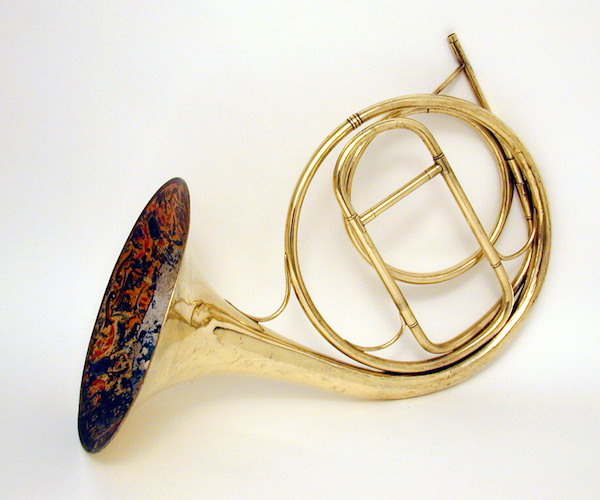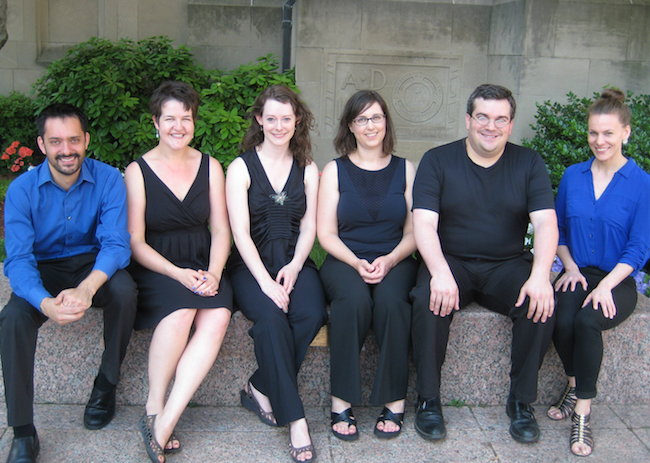Fuse Preview: Grand Harmonie’s Brass Menagerie
This Grand Harmonie program is a survey of both the mainstream and wildly experimental uses of early brass instruments.

Manufactured by Halary, this is a standard orchestral natural horn as used in France from the end of the eighteenth century through the first half of the nineteenth century. Photo: Dick Martz.
By Jonathan Blumhofer
The period-instrument ensemble Grand Harmonie’s ambitious and busy 2015-16 season, which has been spread between Boston, New York, and Princeton, New Jersey, comes to a local close this week with two performances of Brass Menagerie on May 26 and 27, a concert showcasing 18th- and 19th-century scores for brasswinds. Some of the program is, more or less, familiar – it includes Beethoven’s Drei Equali and a pair of Mozart divertimenti – but much of it is not, including, at the end of the first half, Jacques-Francois Gallay’s Grand Quartet for four natural horns. In anticipation of the event, I posed a few questions to Grand Harmonie horn player Yoni Kahn.
Arts Fuse: To begin, for the non-horn player, what are some of the differences between valved and natural horns? What are some of the challenges unique to the latter? How does one work their way around them?
Yoni Kahn: A natural horn is simply a long tube with a mouthpiece at one end and a bell at the other end. If a player just blows into the mouthpiece without any other adjustments, only certain notes (known as the harmonic series) can be achieved – think of a bugler playing “Taps” or “Reveille.” Until the technological developments of the early 19th century, this was the only horn that composers like Bach, Mozart, and Beethoven had at their disposal. The basic playing technique is functionally the same between the natural horn and the modern (or valved) horn, but the differences come in how the player achieves notes outside the harmonic series. On a modern horn, a player can press a key to open a valve which changes the length of the instrument, and combinations of valves give a full chromatic scale over several octaves by combining the harmonic series of the different tubing lengths. On the natural horn, the player must cover the bell with the hand and vary the lip and air pressure to achieve the same chromatic notes. Even then, some lower notes are impossible, so in a horn ensemble, a composer might write for four horns all pitched in various keys to cover the entire chromatic compass. This is exactly what Gallay does in his quartet.
AF: This week’s program offers a selection of fairly disparate pieces written over the late-18th and early-19th centuries. What common threads tie the pieces together?
Kahn: This program is a survey of both the mainstream and wildly experimental uses of early brass instruments. On the one hand, you have the trumpets and the trombones as they were used in ceremonial or liturgical functions – fanfares and marches for the trumpets, solemn chorales for the trombones. On the other hand, you have Mozart building a trumpet choir with instruments pitched in different keys to try to achieve modulations and varied tone colors – this was a trick he and other composers had used with horns, but hearing it for trumpets combined with flutes and timpani is highly unusual. For the horns, the Gallay quartet is the pinnacle of the French style of writing for the natural horn, with florid chromaticism and passagework that only the true virtuosos of the period could navigate.
AF: The Gallay, of course, is a real rarity. How did you come to know it? Is it a piece you’ve performed before?
Kahn: I think I first came across the piece in undergrad, when it was presented as a sort of transposition exercise. All the horn parts are written in different keys, so in a performance on modern instruments, the players have to transpose on sight. I didn’t really understand the point of each instrument being in a different key until I came to the natural horn, where the quartet takes on the texture of a classical sax quartet or a flute quartet – four instruments belonging to the same family, but by no means identical. The 1st horn in G has the bright, vibrant character of a soprano sax, while the 4th horn in low C anchors the ensemble with bass lines and rhythmic pulses like a baritone sax. I’ve performed excerpts from the piece at a natural horn workshop at Indiana University, but never the full piece.

The Grand Harmonie ensemble. Photo: courtesy of the artist.
AF: Your horn is a special instrument. Tell me about it. What’s its history? How did you come to acquire it?
Kahn: I’m extremely fortunate to be able to play on an original French natural horn from Gallay’s time. The horn was made by Halary, one of the best-reputed French makers, around 1830. It has a full set of crooks allowing me to play in all the keys required in orchestral and chamber music, and the bell is hand-painted with much of the design intact. I’m not sure exactly where the horn has been between the 19th century and the 20th century, but it ended up in the hands of a collector in Pennsylvania. After borrowing the horn for several performances, most recently for Grand Harmonie’s performances of Mozart’s Gran Partita, I acquired it permanently last November as an engagement present from my fiancée. Playing on an original instrument – as opposed to a replica – is a fascinating experience, since there are numerous intonation quirks which give the instrument character, but are not what one would theoretically expect in terms of specific notes being flat or sharp. It’s an instrument for special occasions, and the performance of the Gallay quartet is certainly one of them!
AF: Speaking of Gallay, he seems to have been remarkably influential, especially in how his teaching and performing reputation helped hold off the acceptance of the valved horn (at least at the Paris Conservatory) until the early 20th century. As a scientist and musician, what lessons or morals do you take from the example of his influence in this regard?
Kahn: The moral for me is that technological progress is not unambiguously positive. To give a contemporary example, the quality of recorded music and audio technology has progressed to an astounding degree, such that with enough resources and the right arrangement of speakers, you could make your home sound like Symphony Hall. Of course, that’s not the same experience as attending a live concert. The French had no problem with the valved instruments per se (Berlioz advocated treating the valved horn and natural horn as two different but complementary instruments), but they were worried that the individual color and character of each note on the natural horn would be lost to the homogeneity of the valved horn. In fact, this is what has happened in contemporary horn pedagogy: students are encouraged to practice making every note sound exactly the same across several octaves, and skills like this are valued by orchestral audition committees. Gallay might have been a hard-liner by trying to forbid the valved horn, but personally, I’m glad to have discovered the natural horn and to begin to unearth aspects of his tradition. Playing on this instrument is inextricably linked with the spontaneity and risk-taking of live performance, which is what drew me to music in the first place.
Jonathan Blumhofer is a composer and violist who has been active in the greater Boston area since 2004. His music has received numerous awards and been performed by various ensembles, including the American Composers Orchestra, Kiev Philharmonic, Camerata Chicago, Xanthos Ensemble, and Juventas New Music Group. Since receiving his doctorate from Boston University in 2010, Jon has taught at Clark University, Worcester Polytechnic Institute, and online for the University of Phoenix, in addition to writing music criticism for the Worcester Telegram & Gazette
